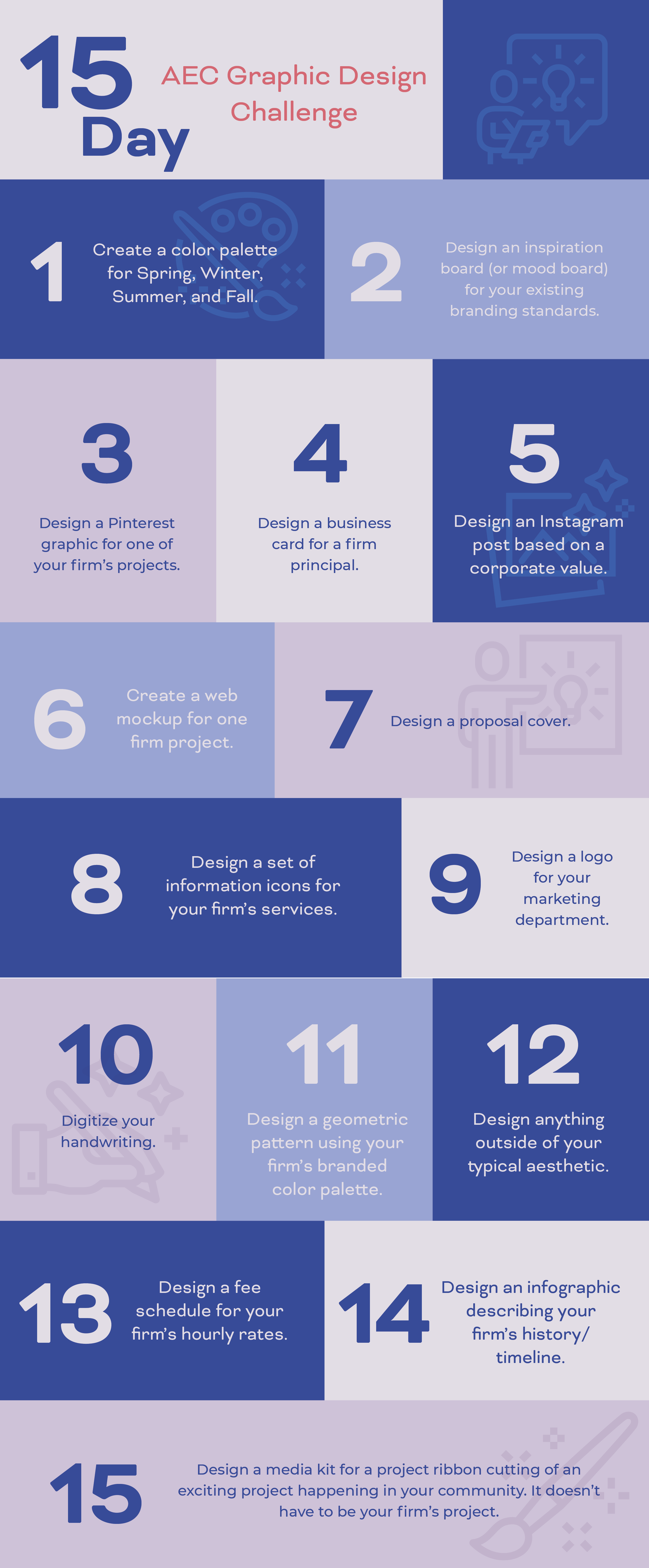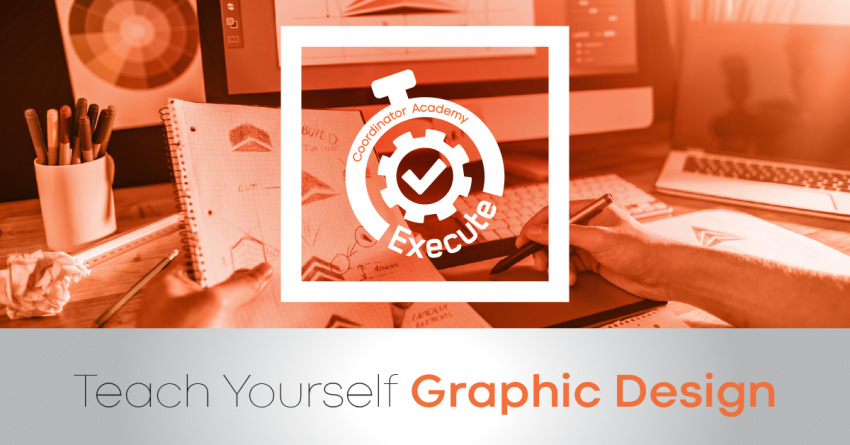A Ten-Step Guide to Teach Yourself Graphic Design Skills
As an AEC marketer, did you know that your job would require so much graphic design knowledge? While some architecture, engineering, and construction firms have the luxury of hiring an in-house designer or the budget to outsource this task, most do not and rely heavily on the skills of internal marketing staff.
As the creative one in the firm, you have surely learned that your marketing team will never run out of design opportunities. Whether its social media graphics, blog posts, proposals, presentations, content upgrades, and even some billable work, design is a necessity for all AEC businesses. Wouldn’t you love to be able to design some of these projects on your own and establish yourself as a graphic resource?
If you don’t have formal training in graphic design, read on. The following ideas will help you learn what you need to know to get started to teach yourself graphic design. By jumping in and following these suggestions, you will have a plan to jump start your new creative venture.
1 | Understand the History of Visual Communication
You didn’t think you could get away without a little history lesson, did you? The demand for visual communication dates as far back as human existence and serves to highlight just how important understanding design history is to learning about design’s use and relevance today. Historians believe that the first cave paintings were created to illustrate stories. Fast forward to the 21st century, where the use of visual elements to communication information and ideas has revolutionized our world.
2 | Dive into the AEC Industry’s Graphic Design Dictionary
You must talk the talk before you can walk the walk. Before you begin learning how to create graphics, you’ll need to learn a few basic design terms. Just like an engineer must learn mathematics and physics terminology, the graphic design world has its own vocabulary. Knowing and understanding those terms is a vital first step in teaching yourself design.
Read our TEKTOK, the ABCs of AEC Graphic Design Terminology and download the cheat sheet before you go any further. These are just a few of the design terms you may want to know. If you are interested in a more specific type of design like brand, web, or packaging design, you’ll want to research those genre-specific terms.
3 | Learn from the Design Experts
Graphic design books, blogs, vlogs and tutorials will help you learn the basics and beyond from the experts. The content is typically free and credible. Online sources stay up to date and teach you about new software, techniques, and latest trends in the world of marketing and design. There are plenty of industry-specific websites you may come across, but don’t discount learning from outside the AEC industry. Some of the best graphic design ideas can come from looking through magazines and other publications. A few credible sources we’ve found include:
Graphic Design:
Brand Design:
4 | Surround Yourself with Those that “Do”
Just like any other industry, graphic designers love to showcase their work, techniques, and methods online. You can follow graphic designers on Instagram, Behance, Dribbble, Pinterest, and YouTube. Instagram and Pinterest are great resources for following designers who possess the skills you would like to develop. You will find more small business owners and freelancers on these platforms. Behance and Dribbble are more professional platforms for agency designers. Outside of blogs, YouTube is the best platform to learn graphic design skills and techniques.
5 | Do Your Homework
It’s important to practice all the design theories that are used by your favorite designers. This is something that is often missed or done incorrectly by beginners. Practicing creating other designer’s work will help you get ideas and learn the design software for real-world uses. Recreating famous or popular work helps you deconstruct the basics of design and learn how to apply them.
Studying, practicing, and recreating a designer’s work isn’t as bad as it sounds. You will not be stealing their work. If you are re-creating other designers' work, only use their work as homework assignments. Don’t share them publicly unless specifically told you are allowed to.
6 | Take Advantage of Free Software
If you or your firm are not sure how invested you are in graphic design, consider free software before purchasing Adobe Creative Cloud software. The free software often comes with templates that can be used by beginners for practice purposes. One of the most commonly used free software is Canva.
Note: If you want to use Canva for business graphics, be careful. The language on their website is a little vague and you don’t want to get in any legal trouble.
7 | Discover the Industry Standard
If you want to get serious about graphic design, you’ll want to know what others use and why. Adobe Creative Cloud is the AEC industry’s standard. The most common Adobe apps, web services, and resources you may use as an AEC marketing professional include:
- InDesign - used for creating text-based documents. Proposals, brochures, and other multi-page documents are best for InDesign. It is not intended for high-level design.
- Illustrator - a vector-based software used for graphics and illustrations. Since it is vector based, it has infinite scale.
- Photoshop - pixel-based software primarily used for photo editing.
- Creative Cloud Express - makes it easy to get started with thousands of templates and assets for social media content, newsletters, logos, etc.
If you aren’t sure what program would be the best for you, we’ve got you covered.
8 | Take Classes Online
Learning these graphic programs on your own can be challenging. If you find that you need some extra help or want more in-depth knowledge, online courses are a handy resource. Programs like Envato Tuts+, YouTube, LinkedIn, Eduonix, Skillshare, and Lynda offer a wide variety of courses and different teaching methods. These types of introductory classes are very helpful when learning the basics. Lynda has learning paths which combine a few of their classes for more comprehensive training.
9 | Practice Makes Perfect
Learning by doing is the only way you can become an expert. Trial and error is the best way to learn how to use the software, implement design theories, improve your skills, and get comfortable with your style. When I was first getting started, I created a project page using one that had already been created. I just replaced the text and images until I felt comfortable and then went on to another task. These self-imposed design challenges helped me learn while working on content.
If you want to push yourself to experiment, here’s a mini design challenge you can take part in.

If you decide to take part in this AEC industry graphic design challenge, share it with us on Instagram. Be sure to tag us @marketlink.aec because we would love to see what you create!
10 | Get the Creative Juices Flowing
As you grow in confidence, you’ll slowly be able to get more and more creative. Jump start your creativity and get inspired! Inspiration can come from exploring new places, disconnecting from electronic distractions, and even taking the time to look at familiar objects in a whole new way.
Whether you are ready to get started and need inspiration, or you want ready-made designs, check out Creative Market. This platform is an excellent resource for handcrafted digital design content from independent creatives around the world. It was created to help those who are not graphic design experts to have access to ready-to-use high design assets. Creative Market has design templates, fonts, illustrations, icons, and everything in between. It’s a great place to get inspired, explore design trends, and find tools to boost your learning and productivity.






